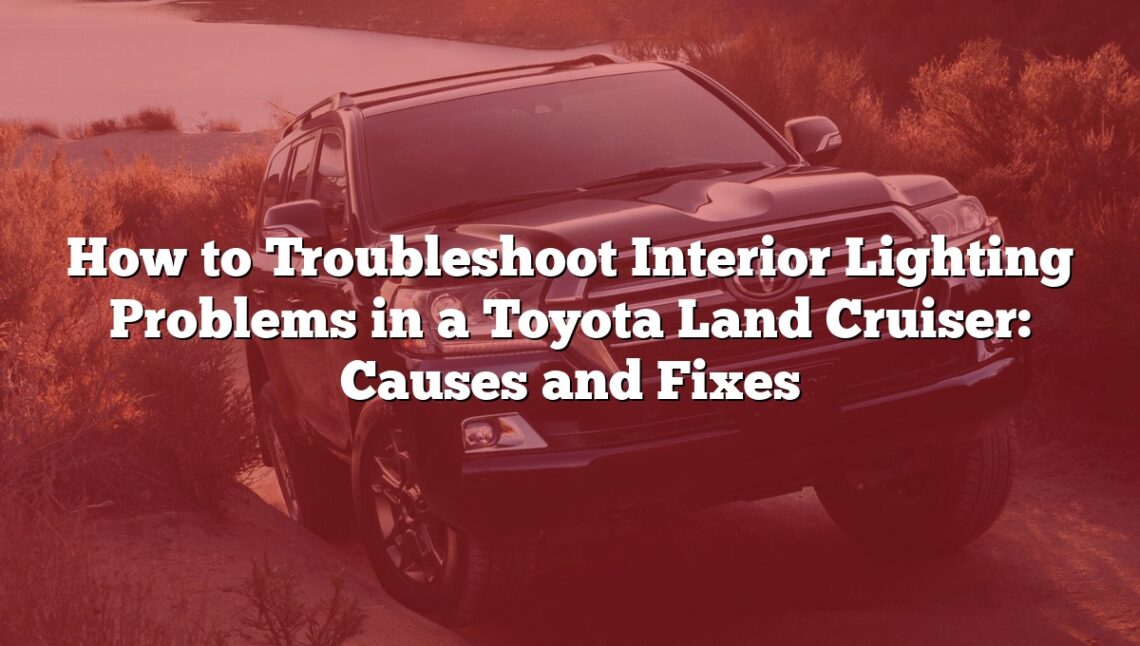Interior lighting issues in your Toyota Land Cruiser can be frustrating and inconvenient, especially at night. From blown fuses to faulty switches, these problems often stem from a variety of common causes. This guide will help you identify the root of the issue and provide clear solutions to get your interior lights working again, ensuring safety and comfort on the road.
How to Troubleshoot Interior Lighting Problems in a Toyota Land Cruiser: 37 Problems and Their Solutions
| N° | Problem/Cause | Solution |
|---|---|---|
| 1 | Blown interior light fuse | Replace the fuse with one of the same type and amperage. |
| 2 | Burnt-out bulbs | Replace the burnt-out bulbs with compatible new ones. |
| 3 | Faulty light switch | Replace the faulty light switch with a new one. |
| 4 | Loose or damaged wiring | Inspect and repair or replace the affected wiring. |
| 5 | Corroded electrical connections | Clean corroded connections or replace them if necessary. |
| 6 | Malfunctioning door switch | Test the switch with a multimeter and replace if it shows no continuity. |
| 7 | Faulty dimmer switch | Adjust or replace the dimmer switch if it’s malfunctioning. |
| 8 | Dead or weak battery | Charge or replace the vehicle’s battery. |
| 9 | Bad alternator | Test the alternator and replace it if it’s not charging the system properly. |
| 10 | Malfunctioning relay | Replace the faulty relay in the lighting circuit. |
| 11 | Faulty light control module | Diagnose the module and replace it if necessary. |
| 12 | Loose ground connection | Tighten or reconnect the loose ground connection. |
| 13 | Software or ECU glitch | Reset or update the software; consult a specialist if the issue persists. |
| 14 | Faulty sensor (e.g., ambient light sensor) | Test the sensor and replace it if it’s malfunctioning. |
| 15 | Water damage in the electrical system | Dry and repair the affected components; replace if necessary. |
| 16 | Worn-out bulb sockets | Replace the worn-out bulb sockets. |
| 17 | Short circuit in the wiring | Trace and repair the short circuit in the wiring. |
| 18 | Overloaded circuit | Reduce electrical load or upgrade circuit components. |
| 19 | Aftermarket accessory interference | Disconnect aftermarket accessories and test; use properly integrated accessories. |
| 20 | Faulty ignition switch | Replace the ignition switch if it’s causing the issue. |
| 21 | Faulty wiring harness | Inspect and repair or replace the wiring harness. |
| 22 | Pinched or severed wiring | Locate and repair damaged wiring. |
| 23 | Incorrect bulb installation | Reinstall bulbs correctly or replace with appropriate ones. |
| 24 | Aging or deteriorated electrical insulation | Replace or repair wiring with deteriorated insulation. |
| 25 | Rodent damage to wires | Inspect for gnawed wires and repair or replace them. |
| 26 | Faulty dome light assembly | Replace the dome light assembly. |
| 27 | Failing or incompatible aftermarket LED lights | Replace LEDs with compatible ones or revert to OEM bulbs. |
| 28 | Faulty power supply to the lighting circuit | Check and repair power supply lines or connections. |
| 29 | Electrical surge damage | Inspect and replace damaged components; add a surge protector if needed. |
| 30 | Problems with the CAN bus system | Diagnose the CAN bus system with specialized tools and repair or reset as needed. |
| 31 | Incorrect settings on the dimmer switch | Adjust the dimmer switch to the correct setting. |
| 32 | Faulty instrument cluster | Replace or repair the instrument cluster. |
| 33 | Bad or misaligned door jamb switch | Realign or replace the door jamb switch. |
| 34 | Broken or disconnected connectors | Reconnect or replace broken connectors. |
| 35 | Damage from repeated wire crimping or bending | Inspect and repair or replace damaged wires. |
| 36 | Manufacturer recalls affecting interior lighting | Check for recalls and follow manufacturer instructions for repairs or replacements. |
| 37 | Defective or incompatible replacement parts | Replace defective parts with compatible or OEM components. |
Detailed Guide : Problems and Their Solutions
1. Blown Interior Light Fuse
- Reason: A fuse may blow due to an electrical overload or short circuit.
- Solution:
- Locate the fuse box (typically under the dashboard or in the engine bay).
- Identify the interior light fuse using the diagram on the fuse box cover.
- Remove the fuse using a fuse puller and inspect it for a broken filament or blackening.
- Replace with a fuse of the same type and amperage.
2. Burnt-Out Bulbs
- Reason: Interior light bulbs may wear out over time or due to voltage issues.
- Solution:
- Remove the light cover using a screwdriver or pry tool.
- Twist and remove the old bulb.
- Insert a new bulb with matching specifications. Avoid touching the bulb with bare hands.
3. Faulty Light Switch
- Reason: The light switch may fail mechanically or electrically.
- Solution: Replace the faulty switch with a new one. If unsure how to replace it, consult a mechanic for professional assistance.
4. Loose or Damaged Wiring
- Reason: Wires may become loose or damaged due to vibrations or wear and tear.
- Solution: Inspect wiring connections and repair or replace damaged sections using electrical tape or a soldering tool.
5. Corroded Electrical Connections
- Reason: Moisture or dirt can corrode electrical terminals.
- Solution:
- Disconnect the power source.
- Clean the connections with a wire brush or electrical contact cleaner.
- Reconnect and test.
6. Malfunctioning Door Switch
- Reason: A faulty door switch can prevent lights from turning on when doors are opened.
- Solution:
- Test the switch with a multimeter.
- Replace the switch if it shows no continuity.
7. Faulty Dimmer Switch
- Reason: The dimmer switch may be turned down or malfunctioning.
- Solution:
- Check the dimmer setting and adjust it.
- Replace the switch if it does not respond to adjustment.
8. Dead or Weak Battery
- Reason: Insufficient power from the battery may affect lighting.
- Solution: Test the battery and recharge or replace it if necessary.
9. Bad Alternator
- Reason: A failing alternator may not provide adequate power to the lighting system.
- Solution: Test the alternator using a multimeter and replace it if needed.
10. Malfunctioning Relay
- Reason: A defective relay can interrupt power flow to the lights.
- Solution: Locate the relay in the fuse box, replace it, and test the system.
11. Faulty Light Control Module
- Reason: The control module may malfunction due to age or damage.
- Solution: Have the module diagnosed and replaced by a certified technician.
12. Loose Ground Connection
- Reason: A poor ground connection can disrupt the lighting circuit.
- Solution: Tighten or reconnect the ground wire to restore functionality.
13. Software or ECU Glitch
- Reason: A glitch in the electronic control unit (ECU) may cause lighting issues.
- Solution: Reset the ECU by disconnecting the battery for a few minutes. If the issue persists, update or repair the software with professional help.
14. Faulty Sensor (e.g., Ambient Light Sensor)
- Reason: A defective sensor may fail to trigger the lights.
- Solution: Replace the sensor after testing it with a diagnostic tool.
15. Water Damage in the Electrical System
- Reason: Water intrusion can short-circuit the lighting system.
- Solution: Dry the affected areas, repair or replace damaged components, and seal entry points.
16. Worn-Out Bulb Sockets
- Reason: Over time, sockets can become loose or corroded.
- Solution: Replace the bulb socket with a new one.
17. Short Circuit in the Wiring
- Reason: Exposed or frayed wires may create a short circuit.
- Solution: Inspect the wiring harness, isolate the damaged wire, and repair it with insulation tape.
18. Overloaded Circuit
- Reason: Adding excessive electrical components may overload the system.
- Solution: Reduce the electrical load by disconnecting non-essential devices or upgrading circuit components.
19. Aftermarket Accessory Interference
- Reason: Poorly integrated accessories can interfere with lighting.
- Solution: Disconnect the accessory and check functionality. Use only properly integrated or OEM accessories.
20. Faulty Ignition Switch
- Reason: A failing ignition switch can interrupt power to the lighting system.
- Solution: Replace the ignition switch.
21. Faulty Wiring Harness
- Reason: The wiring harness may be damaged or disconnected.
- Solution: Inspect, repair, or replace the harness.
22. Pinched or Severed Wiring
- Reason: Wiring may become pinched during repairs or severed due to damage.
- Solution: Locate and repair or replace damaged sections.
23. Incorrect Bulb Installation
- Reason: Improperly installed bulbs may not connect properly or may cause a short.
- Solution:
- Remove the incorrectly installed bulb.
- Verify it matches the specifications for the socket.
- Reinstall the bulb correctly, ensuring it fits snugly in place.
24. Aging or Deteriorated Electrical Insulation
- Reason: Over time, insulation can crack or degrade, exposing wires.
- Solution: Replace deteriorated wiring sections with new wires and secure with proper insulation.
25. Rodent Damage to Wires
- Reason: Rodents can chew through wires, causing open circuits or shorts.
- Solution:
- Inspect the wiring for chew marks or severed sections.
- Repair or replace the damaged wires.
- Use rodent deterrents to prevent future damage.
26. Faulty Dome Light Assembly
- Reason: The dome light assembly itself may fail due to mechanical or electrical faults.
- Solution: Replace the dome light assembly with a new one compatible with your vehicle model.
27. Failing or Incompatible Aftermarket LED Lights
- Reason: Some aftermarket LEDs may not be compatible with the vehicle’s electrical system.
- Solution:
- Replace aftermarket LEDs with OEM-compatible LEDs or standard bulbs.
- Verify the new bulbs meet the vehicle’s voltage and wattage requirements.
28. Faulty Power Supply to the Lighting Circuit
- Reason: Power supply disruptions can prevent lights from functioning.
- Solution: Inspect power supply lines for damage, test voltage levels, and repair or replace faulty connections.
29. Electrical Surge Damage
- Reason: Surges can damage components in the lighting circuit.
- Solution:
- Identify and replace damaged components (e.g., bulbs, fuses).
- Consider installing a surge protector to prevent future issues.
30. Problems with the CAN Bus System
- Reason: Faults in the vehicle’s communication system can disrupt interior lighting.
- Solution: Use diagnostic tools to identify faults in the CAN bus system and repair or reset as needed.
31. Incorrect Settings on the Dimmer Switch
- Reason: The dimmer switch may be set too low or accidentally turned off.
- Solution: Adjust the dimmer switch to the correct brightness setting.
32. Faulty Instrument Cluster
- Reason: A malfunctioning instrument cluster can affect interior lighting.
- Solution: Have the instrument cluster professionally repaired or replaced.
33. Bad or Misaligned Door Jamb Switch
- Reason: A door jamb switch may become misaligned or fail over time.
- Solution:
- Inspect the switch for alignment.
- Adjust its position or replace it if it fails continuity tests.
34. Broken or Disconnected Connectors
- Reason: Connectors may break or come loose due to wear or handling.
- Solution: Reconnect or replace the broken connectors and ensure secure connections.
35. Damage from Repeated Wire Crimping or Bending
- Reason: Frequent bending can weaken or break wires over time.
- Solution: Repair or replace damaged wires with new, unbent sections and secure them to prevent movement.
36. Manufacturer Recalls Affecting Interior Lighting
- Reason: Some models may have known issues addressed by recalls.
- Solution: Check for active recalls on your vehicle and follow the manufacturer’s instructions to address them.
37. Defective or Incompatible Replacement Parts
- Reason: Non-OEM or poorly manufactured parts may not function correctly.
- Solution: Replace defective parts with OEM or high-quality compatible components.
Preventing Future Issues
To avoid recurring interior lighting problems in your Toyota Land Cruiser, follow these steps for regular maintenance and preventive care:
- Inspect and Maintain Wiring Regularly
- Check all visible wiring for signs of wear, corrosion, or damage.
- Use electrical tape or replace damaged sections immediately to prevent shorts or power loss.
- Replace Components with OEM Parts
- Always use Original Equipment Manufacturer (OEM) parts for replacements, as they ensure compatibility and reliability.
- Avoid using incompatible aftermarket components that can cause electrical issues.
- Keep Electrical Connections Clean
- Periodically clean connections with an electrical contact cleaner to prevent corrosion.
- Ensure all connections are tight and secure after cleaning.
- Protect the Wiring from Rodents
- Use protective sleeves or rodent deterrent sprays around wiring, especially if you park the vehicle in rodent-prone areas.
- Check the Fuse Box Regularly
- Inspect the fuse box for signs of blown fuses or loose connections.
- Replace worn or faulty fuses with the correct amperage immediately.
- Avoid Overloading the Electrical System
- Disconnect non-essential electrical devices when not in use.
- Ensure that added accessories, such as LED lights or sound systems, are properly integrated and do not overload the circuits.
- Keep the Interior Dry
- Prevent water intrusion by checking seals around doors and windows.
- Dry the interior quickly if it gets wet to avoid moisture-related electrical damage.
- Perform Regular Battery and Alternator Checks
- Test the battery and alternator during routine maintenance to ensure they provide consistent power.
- Replace aging or weak batteries and repair alternator issues promptly.
- Update Software and Check Recalls
- Keep your vehicle’s ECU software updated by visiting an authorized service center.
- Regularly check for manufacturer recalls related to the lighting system and act on them as needed.
- Schedule Periodic Professional Inspections
- Have a certified mechanic perform a detailed inspection of the vehicle’s electrical system at least once a year.
- Address potential issues early to avoid costly repairs later.
By following these steps, you can significantly reduce the chances of experiencing interior lighting problems in the future and maintain the functionality of your Land Cruiser’s lighting system.







